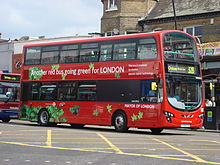
Hybrid buses are operated on a small number of bus services in London. The first were introduced in March 2006, and 56 are now used. Transport for London has stated that it intends to make all new buses delivered for use in London hybrids from 2012.

Hybrid buses are operated on a small number of bus services in London. The first were introduced in March 2006, and 56 are now used. Transport for London has stated that it intends to make all new buses delivered for use in London hybrids from 2012.
Hybrid electric buses use a combination of an electric battery pack and a diesel engine to provide power, and produce around 40% less Carbon Dioxide (CO2) emissions than traditional diesel engined buses. Energy generated during braking is used to charge the batteries of hybrid vehicles.[1] Later in 2006 the vehicles were temporarily withdrawn from service when their diesel engines overheated.[2]
Transport is responsible for around 20% of London's CO2 emissions; buses make up 5% of the transport total. The city has set a target of a 20% reduction in emissions by the year 2020. Converting London's entire bus fleet to hybrid vehicles would reduce CO2 emissions by around 200,000 tonnes per year.[2]
Other low-emission buses have also been used in London. Three hydrogen fuel cell powered buses were used on route 25 from 2004, but have since been withdrawn; a batch of five are expected to be introduced to route RV1. An ethanol fuelled double-decker bus was operated by Transdev London in 2008 and 2009.[3]

The first hybrid buses to enter service in London were six Wright Electrocity single-deckers. These were ordered in March 2005 to operate on route 360.[4] The buses were unveiled by the then Mayor of London, Ken Livingstone, on February 7, 2006, with the intention of starting operation on the following day.[5]
A double-deck hybrid vehicle intended for use in London was unveiled in October 2006. The bus, which cost £285,000 and was constructed by Wrightbus, was the first hybrid double-decker in the world, and was painted in red and green to symbolise the environmental benefits.[6] It entered service in February 2007 on route 141.[1]
No more hybrids were delivered until December 2008, when twenty-five vehicles entered service. These were introduced onto five routes run by four different operators. A further eighteen were due to follow in January 2009.[7] However, the last of these did not enter service until July, when six Volvo B5L double-deckers joined the existing vehicles on route 141.[8]

106 hybrid buses are currently in use in London, operating on routes 16, 24, 76, 94, 139, 141, 149, 243, 276, 328, 360, 371, 482 and E8.[9]
A variety of models of hybrid vehicle are currently used. These include the Wright Electrocity and Optare Tempo single-deckers and the Volvo B5L, Wright Gemini 2 and Alexander Dennis Enviro400 double-deckers.[3] Route 141 used to be the only route that operated with two types of hybrid.[8]
The introduction of hybrid vehicles in London has received praise from the Low Carbon Vehicle Partnership, which awarded Transport for London the first ever Low Carbon Champion Award for Buses in July 2010.[10]
Transport for London has stated that it intends to have introduced around 300 hybrids into service by 2012, and that all new buses delivered after that date will be hybrid vehicles.[9] Twenty double-decker hybrids are currently on order for use by Arriva London on route 73 from September 2011.[11][12]
31 hybrid double deckers are currently on order for use by Go-Ahead London on routes 436 and 453 from November 2011. 26 hybrid double deckers will be used by Metroline on routes 16 and 139 from late 2011; a further 13 are currently on order for use by Abellio on route 188 from late 2011.[12]
From December 2011, route 15 will have ADL Enviro400 hybrid; Abellio will have 22 new ADL Enviro400 hybrid buses for route 3 with new contract.